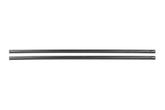Why do we need often replace Wiper Blades?
This is a question we often ask ourselves while changing wipers. The fact is, though, that all wiper blades eventually wear out. By understanding the factors that contribute to your wipers deterioration, you can help to prolong their life. And by being conscientious about the lifespan of the wiper blades, you won’t be faced with an untimely replacement in the middle of any spring thunderstorm.
How Weather Affects Wiper Blades
The biggest factor to the wear on your wiper blades could be the climate and elements they are exposed to. Specifically, in the spring and winter of some region of Australia, your wipers are working hard to combat heavy rains and dirty. And the harder they work, the quicker they stop working. However, no one can control the freezing temperatures that cause squeegee to become hard and brittle and eventually crack.
Heat and sunlight are also harmful to the rubber on the wiper blade. The warm temperatures we are all looking forward to cause the wiper squeegee to warp, and again, crack faster. This is especially true in a dryer climate. You can slow down the effects of sunlight by parking under structures whenever possible. Over time, though, the elemental factors add up and your wiper blades will become less flexible and stop working properly.
How Dirt and Your Car Affect Wiper Blades
Your car and your wipers are connected, they should work together right? Unfortunately, the oils and exhaust that your car puts out is damaging to the wiper’s squeegees. The chemicals cause the rubber to break down and deteriorate. Likewise, dirt and grime from the road wear down the cutting edge of the wiper blades.
Take the time to thoroughly wipe down each blade when you stop at a gas station, removing built up dirt and oils. Make sure you also keep your windscreen clean, preventing the blades from having to run over a rough surface. And invest in quality wiper blades that are engineered to withstand the harmful effects of chemicals and oils better than the standard rubber squeegees.
How You Harm Your Wiper Blades
There are several things that drivers accidentally do that harm their wiper blades. One is unintentionally flipping the wipers on when the windscreen is dry. This not only can cause scratches on the windscreen, but can wear down the blade as it runs into an unyielding surface. By turning on wiper blades that are iced over or stuck in the windscreen’s ice, you risk tearing off bits of the squeegee or cracking the arms. Even your choice in windscreen wiper fluid can be harmful, as some include chemicals that contribute to the breakdown of rubber.
Make sure to repair any nicks or scratches in your windscreen quickly. Be careful that your windscreen is fully defrosted and clear of ice in the winter before turning on your wipers. By choosing a quality wiper blade provide by us, you can extend the life of your windscreen wipers.








